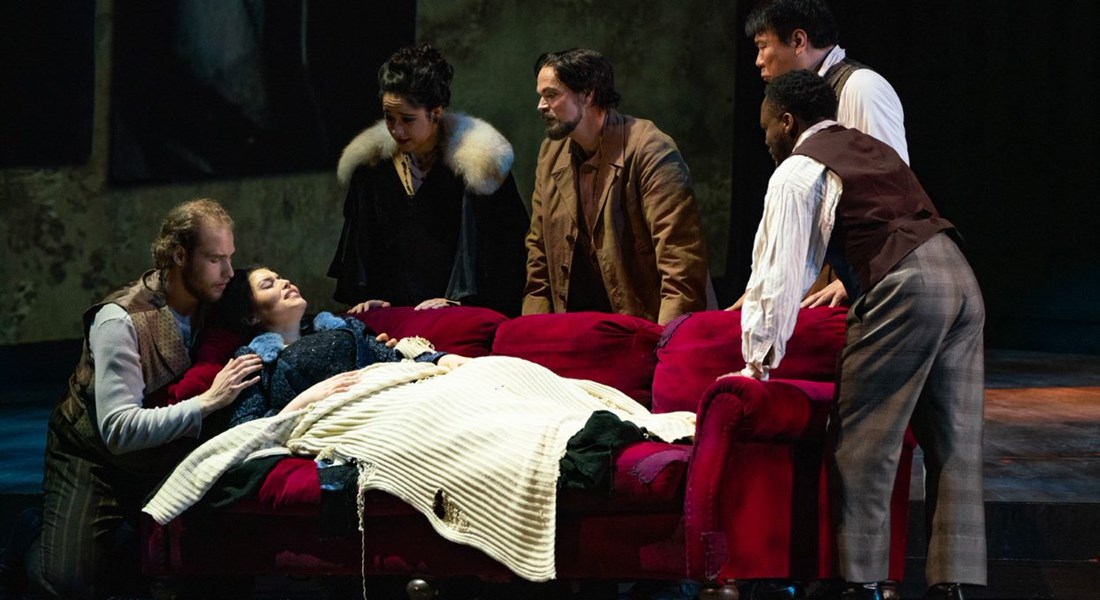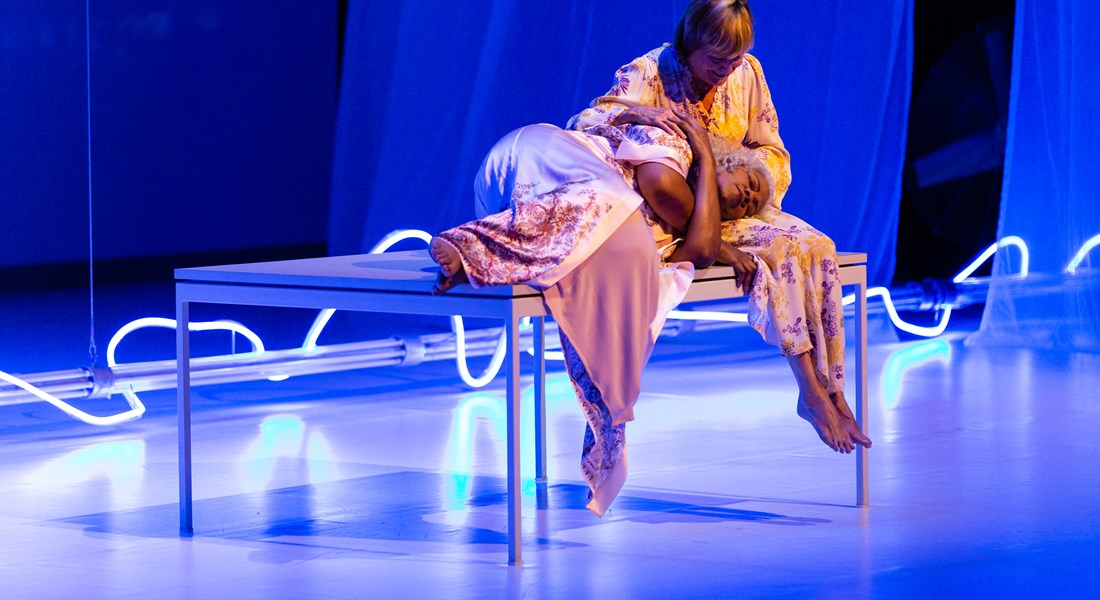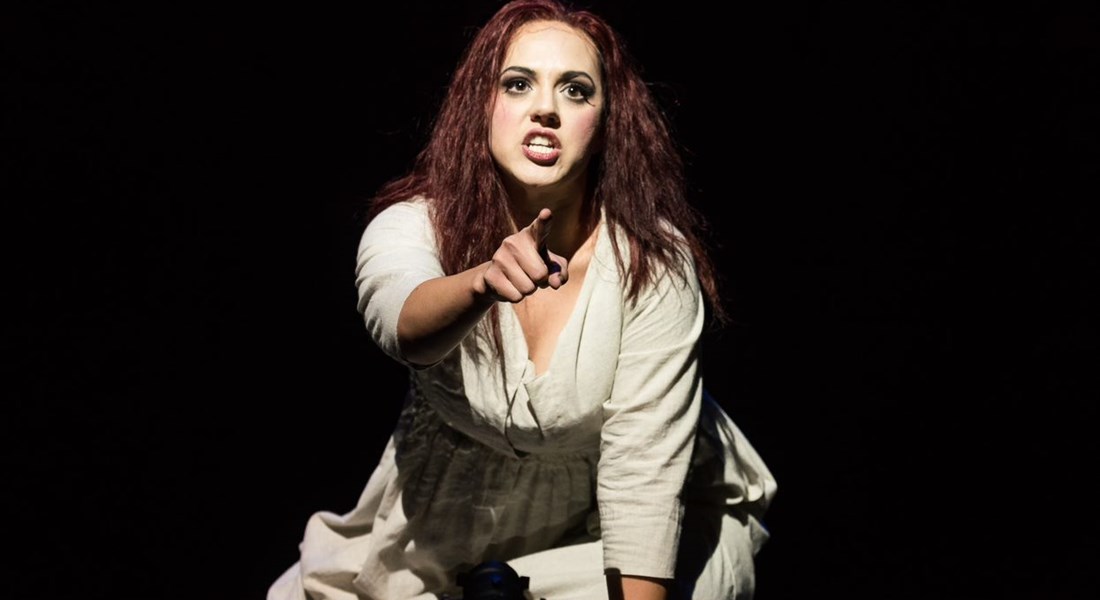Posted21 Sep 2019
- In
Curtains: Why does opera have a historic fascination with death?
“Here we are again!” sings Elizabeth Cree as she hangs from a noose center stage at Philadelphia’s Perelman Theater, swinging ominously as she’s lifted into the rafters. Across the street at the Wilma Theater, teens bemoan “killin’ in Philadelphia” in We Shall Not Be Moved, surrounded by the ghosts of martyred activists who came before them. A year earlier in the Perelman, a religious woman named Bess McNeill dies after a brutal attack from a group of sailors in Breaking the Waves; and a few blocks away at the Prince Theater, a Congolese murderess can’t wash the blood off her hands in Macbeth.
Elizabeth was right: death shows up at every turn in opera stories of stabbings, suicides, and tuberculosis have run through libretti since the beginning. Joseph Keckler had plenty of deaths to choose from as he crafted Let Me Die, his O19 world premiere, which juxtaposes a fraction of the genre’s many famous death scenes with original narrative and music.
What is it about opera that invites so many onstage deaths—and what is it about opera audiences that keeps us coming back to experience them? We go to the opera knowing that its characters are about to break our hearts. The art form sets up spoilers by default: we read synopses before the performances begin, or are hearing classic tales that have been retold many times over. By dispensing so efficiently with plot, operas are freed to focus on the emotional storytelling that gets them there, building to these deaths musically in myriad ways. Death can be a release, an indictment, a moment of catharsis, or a lonely act; sometimes, all at once.

In a 2015 blog post, opera singer Kristen Seikaly looked at 42 of the most-produced operas and found that nearly all operatic deaths fall into three categories: illness, murder, and suicide. While illness is the least common cause of death in opera, making up 17% of operatic deaths, it is the dramatic focus of two of the most famous: La bohème and La traviata. In both works, the lead sopranos—Violetta in traviata and Mimì in bohème—suffer painfully gradual deaths. The audience knows exactly what’s going to happen to Mimì and Violetta, as do they, but the music teases us with glimmers of false hope.
In the traviata aria “Addio del passato,” Violetta knows she’s done for, but the aria’s shift from a minor to a major key, paired with large ascending melodic intervals, evoke a possible reprieve. Even in her death, there is a moment when Violetta appears to be reviving: her high notes soar and wail, only to come crashing down as she dies in Alfredo’s arms. In the orchestral interludes, Verdi tugs at the audience’s heartstrings with instrumental aches and sighs as Violetta’s health declines. Librettist Arrigo Boito, a later Verdi collaborator, wrote about his experience of these interludes at traviata’s premiere: “The prelude says this with sounds, with elevated, sad and frail sounds, almost disembodied, ethereal, sick with imminent death…that silence, quiet and painful, created by sounds! The soul of a dying woman tied to her body by the subtlest thread of breath!” These potent musical representations of Violetta’s declining health and emotional state makes traviata’s conclusion all the more heart-wrenching.
Forty-some years after the premiere of La traviata, Puccini expands on Verdi’s techniques of musical storytelling in La bohème. In Mimì’s final scene, there’s a moment where it appears that her tuberculosis is lifting, much like Violetta’s. Her aria builds to a tender climax reminiscent of earlier musical material, oozing with hope amidst hardship with every ascending contour and orchestral swell. But unlike Violetta’s dramatic demise, Mimì slips away quietly, as though merely asleep. Mimì’s voice on her last words is small and simple, marked pppp in the score. We in the audience realize her death minutes before her lover does, but are powerless to intervene.
Violetta and Mimì’s gradual deaths encourage us as audience members to pity the dying and sympathize with those left to grieve. Gender norms also come into play: Violetta and Mimì die pitifully by disease, rather than dying bravely in battle or spectacularly with murder.
Even if we approach these characters with twenty-first-century skepticism, the music of both operas can still overpower our analytical minds while we watch. The author Ann Patchett beautifully describes the experience of watching La bohème at a Metropolitan Opera simulcast in a Nashville movie theater. “The way I cried at the end of La bohème was expected,” she writes, “and when my friend Beverly in Texas called later that night to tell me how she had cried we both said, ‘Mimì! Mimì!’ over the phone and started to cry again.”Even though both women knew Mimì’s fate going into the performance, the devastating effect of her death on them wasn’t lessened. Their emotional investment as audience members was heightened by anticipation, and by being powerless observers as Mimì fights to avert her fate. Like Patchett and her friend, we filter the circumstances of the doomed love of traviata and bohème through our own lives, inserting ourselves into their heartbreak.
While Mimì and Violetta approach their powerless descent into disease with resignation and sorrow, the women at the heart of Lembit Beecher and Hannah Moscovitch’s contemporary opera Sky on Swingsare mad as hell. Danny, the researcher at the heart of the story, knows exactly what Alzheimer's Disease is about to do to her body and mind: “Your facility is charming and I can’t wait to move in and lose my fucking mind and then die,” she spits at a patronizing nursing home aide. When her friend Martha hunts for matches in her once-familiar home, her repetitive rhythms on a single note whip up into a frenzy, cut by her raw recitative that “it makes no damn sense.” The musical settings make their anger radiate off the stage, engulfing us as audience members in the sheer unfairness of what these women are experiencing.

After living in this place of bitterness and fear, the kinship that Danny and Martha feel when they meet one another offers the audience a hard-earned respite. Unlike the women before them, they don’t have to experience this alone, and this commiseration blooms into a tender connection. Love gives them agency and unites them, even in Martha’s death. This makes Martha’s passing a release rather than a tragedy: “I love you. I’m home,” Danny sings as she sits with Martha’s body. Instead of imploring the audience for pity for the characters, Sky on Swings’ conclusion emphasizes Danny and Martha’s courageous living in the face of decline and death.
While death by illness can offer catharsis and release, murder in opera brings audiences morbid thrills and lonely chills. In Mozart’s Don Giovanni, murders are musically delicious, marked by jolting diminished chords and adrenaline-fueled tempi. In Kevin Puts and Mark Campbell’s Elizabeth Cree, a serial killer’s spree is tracked through a lurid vaudevillian lens, reveling in every spurt of blood. These thrilling and energetic musical gestures keep us on the edge of our seats, but they also keep the deaths themselves at arm’s length. Like any good ghost story or murder mystery, they take us on a hair-raising ride that distances us as audience members from violence’s very real consequences.

Breaking the Waves, by composer Missy Mazzoli and librettist Royce Vavrek, interrogates this thrill of watching operatic murder. Throughout the work, the orchestra churns like the sea that confines the protagonist Bess on the Isle of Skye. After Bess’ husband Jan is paralyzed, he pressures her to sleep with other men and tell him about them, dooming her to life as a pariah. Through the orchestra’s murky depths, Bess’ voice—particularly as debuted by the soprano Kiera Duffy—cuts through with knife-like precision, teetering between love and obsession. Rather than enveloping audiences in a murderous mood, the orchestra leaves us feeling as isolated as Bess, accentuating her loneliness as she veers farther from her community’s idea of womanhood.
While the music during Bess’ murder and gang rape is jarring and graphic, jerking to and fro with asymmetrical rhythms, the moment of her death itself is hushed. In her final scene, Bess’ vocal lines pivot from piercing intensity to practically a whisper. Like in La bohème, her voice is quiet, but the effect is of stark musical isolation. She doesn’t get Violetta’s release of dying in her lover’s arms, or the brash musical jolts of Don Giovanni. Instead, she’s marooned on a hospital bed, flatlining before her friend Dodo can hold her. Her death offers audience members a different color of experiencing grief, one that is more jarring than cathartic. Through spine-tingling, dissonant sonorities, Mazzoli brings the audience right up to Bess’ bedside, making her experience of violence uncomfortably real.
The final type of operatic death—suicide—is present throughout Opera Philadelphia’s 19-20 season, showing up in Semele and Madame Butterfly. Suicide elicits perhaps the messiest and most complicated emotions of operatic death types. One of opera’s most famous suicidal protagonists, Werther from Jules Massenet’s opera of the same name, even has a social science term named after him. The “Werther Effect” refers to a spike in copycat suicides after a well-publicized one.
If presenting suicide on stage can have negative social consequences, why present it at all—and why do we seek it out as audience members? The treatment of suicide in George Benjamin and Martin Crimp’s Written on Skin pose its a two-fold answer to this question. Taking the audience from the present day to 800 years prior, the opera centers on an affair between Agnès, the wife of a wealthy landowner, and an illustrator called The Boy. When Agnès and The Boy begin their affair, it is done with the hope that they can control their own destinies, despite how their story has been foretold in the present day. But they cannot escape: Agnès’ husband murders The Boy, and forces Agnès to eat her lover’s heart.
Despite fate’s inexorable pull, Agnès ultimately has the power to create her own death. “Here, look, the man takes a knife but the woman’s quicker, and jumps,” illustrates The Boy, “See how her body has dropped from the balcony, how I pause her mid-fall at the exact centre of the page.” The music at this moment is not loud and climactic, but eerily still. Through it all, three angels watch from the sidelines. “In their face, in their eyes, see their cold fascination with the human disaster,” The Boy describes, “as they turn from the falling woman to where the white lines of the Saturday car park cover the heaped-up dead.”
By freezing the moment of Agnès’ agency in time while the angels watch, Benjamin and Crimp bring our focus away from the action on stage to our own psyches. On the one hand, the way the angels watch Agnès’ suicide indicts our own morbid fascination with watching juicy, dramatic deaths, challenging us to dissect our emotions in the moment. On the other, Agnès’ drastic exercise of agency presents a provocative lesson for our contemporary lives, which are filled with choices to the point of emotional paralysis. Agnès does not die to give us a safe emotional hit of adrenaline or pity. Instead, her death offers a warning about how we observe and act outside of the theater.
In Opera Philadelphia’s 2019-2020 season, death and love remain tightly enmeshed, with death as desperate self-sacrifice (Madame Butterfly) and shockingly public performance (Denis & Katya). The act of dying elicits evergreen fascination from artists of all kinds, but opera’s storytelling through music, text, staging, and design makes it an ideal medium for pondering the question of death. Opera’s melodic contours connect the characters’ experiences onstage to us in the audience in a way that text or visual imagery can’t do on their own. Stories of empathy and emptiness, of loneliness and longing, are far older than opera itself, but they become staunchly modern as we experience them anew from our seats.
Julia Mauro Bumke is a Philadelphia-based dramaturg who specializes in contemporary opera. She served as the dramaturg on O17’s The Wake World, and designed supertitles for We Shall Not Be Moved, Sky on Swings, and Denis and Katya.
This piece appears in the O19 Festival Book.
Leave your comment below.

 Facebook
Facebook Twitter
Twitter More
More